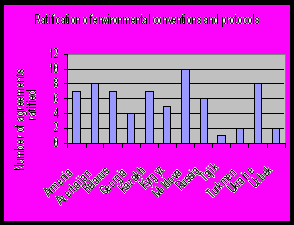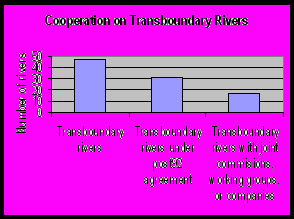Assessing Implementation of the eecca environmental Partnership Strategy – a baseline Report
| Вид материала | Документы |
- 1 моніторинг якості води результати хімічних аналізів, 168.04kb.
- Альянс медиа www allmedia, 37.91kb.
- Курс разработан на основе icb ipma competence Baseline. Version 0 Международной ассоциации, 41.45kb.
- Manual for the Design and Implementation of Recordkeeping Systems (dirks), 1279.81kb.
- Environmental Working Group (ewg) Яблоки возглавляют список, клубника на третьем, 45.95kb.
- Experience of tqm principles and iso 9000 implementation in the Pridneprovsky region, 67.13kb.
- Report of the Secretary-General on ip telephony, 249.71kb.
- 1 Report on activities carried out during the reporting period, 1773.42kb.
- *Сокращенный перевод кэкц. Опубликовано: Environmental values, 2006. V. 15,, 167.96kb.
- Physics Performance Report [2] и в программу исследований эксперимента na61 [3], 91.43kb.
Objective 7. Identify and Address Transboundary Problems and Strengthen Cooperation within the Framework of International Conventions
Several key environmental issues in EECCA have a transboundary dimension and thus managing them requires international cooperation. For example, the Caucasus and Central Asia are experiencing major problems in the management of shared rivers. In many cases, multilateral environmental agreements offer good frameworks to tackle those issues. This section also looks more closely at the case of water, as it could be argued that progress in such a thorny issue may be a good indicator of overall progress in tackling environmental issues multilaterally.
Participation in Multilateral Environmental Agreements
One way of approaching measuring progress on this objective is through the lens of multilateral environmental agreements (MEAs). A fair share of policy formulation in EECCA has been done at the international level – through global, regional, and subregional conventions.
Ratification of MEAs is uneven across the region. For instance out of 15 MEAs analyzed Moldova has ratified 10 and Tajikistan only one. At the same time, there is now widespread concern that signature and ratification of multilateral environmental agreements (MEA) is no longer an indication of the likelihood of effective implementation. It would be useful to know more about country capacity to implement MEAs, as there is little value in ratifying agreements that will not be implemented.
Monitoring Progress ________________
For the purpose of this report, OECD staff has compiled information on EECCA countries’ participation in a subset of 15 MEAs (conventions and protocols) in areas on which the Strategy focuses – namely Air Pollution, Waste and Chemicals, Water, Biodiversity, Environmental Assessment, and Public Participation. The indicator shows the number of MEAs that each EECCA country has ratified. The agreements reviewed are: the Water convention and its Health protocol; the LRTAP convention and the four associated protocols signed after 1992; the EIA convention; the Industrial Accidents convention; and the Aarhus, Basel, CITES, PIC, and POPs conventions.

Source: Conventions’ websites
Transboundary problems: Water
There is considerable inter-dependence between EECCA countries with regard to water resources, as many water allocation and pollution problems that were previously national issues within the Soviet Union are now transboundary issues. In particular in Central Asia, cooperation between countries sharing rivers such as Syr Daria and Amu Daria is crucial for life, economy and political stability. The reliance of Azerbajian on drinking water from the transboundary river Kura is another example. This requires a new and negotiated legal and regulatory framework for water resources management between sovereign States, which will take some time to achieve.
There is generally a positive attitude towards establishing good cooperation on transboundary water issues in EECCA, and cooperation in many transboundary rivers basins is developing well. Several new agreements have been concluded and joint commissions have been established. However, examples can be found where there are difficulties in establishing good cooperation. In some cases agreements have not yet been established between countries. If there are agreements, these are not always fully implemented, and may not be effective tools to tackle the relevant issues, nor address social, economic and environmental aspects.
Cooperation takes place substantively within the framework of the relevant international convention – the Convention on the Protection and Use of Transboundary Water Courses and International Lakes. This convention is directly referred to in the Preamble of several recent agreement and its provisions are used in substantive articles. But there is scope for further work. Several EECCA countries are not yet parties to the Convention. And the Convention, a decade old, does not fully deal with several issues – such as landscape protection, ecosystem approach, flood protection, and water allocation.
Competition among water users on how to share water internationally between upstream and downstream countries is in many cases not resolved. For example, in Central Asia upstream countries prioritise the use of water for hydroelectricity generation n winter while downstream countries mainly use water for irrigation in summer. Reasonable and equitable use of water resources does not seem to be agreed on in river basins such as the Kura or the Samur, both in the Caucasus.
An important obstacle to improved cooperation is the lack of a legal and regulatory framework for bilateral and multilateral cooperation. But cooperation in this area also suffers from many of the bottlenecks associated to national water management – such as weak institutions and poor monitoring programs (see section on IWRM). Indeed, cooperation on transboundary waters cannot be seen as a task separate from other national and international tasks of authorities responsible for water management.
Monitoring Progress ________________
A crude way of tracking progress in cooperation on transboundary waters is looking at the number of rivers under some form of agreed joint management. Because some countries are locked into unfavourable agreements dating back to the Soviet era, the indicator below focuses on agreements signed after 1992. To try to take into account efforts towards actual implementation, the number of rivers with permanent joint bodies is also shown.

Facilitating Progress ________________
The organizations that have been designated as facilitators of this objective are UNECE and UNEP.
Cooperating institutions include UNDP, the RECs, and the secretariats of UNCBD and UNFCCC.
Main information sources ____________
UNECE, UNEP/ROE, Ministry for Natural Resources of the Russian Federation, Swedish EPA and Ecoterra. 2003. Transboundary Water Cooperation in the Newly Independent States.
1 Although environmental degradation and resource scarcity do not directly lead to conflict, they can contribute to accelerating already existing political, social crises and instability. At the same time, environmental cooperation can be a powerful tool for preventing conflict, building mutual confidence, and promoting good neighbourly relations, including patterns of co-operation and collaboration that can later extend to other areas
2 Note for section 7: There is scope for cooperation between countries in the area of alternative waste treatment, as several may not generate sufficient quantities of certain wastes to treat them in an efficient way.
3 There are no data available that would allow analyzing environmental expenditures in a strict sense. This report uses ‘environmental expenditure’ as short for the broader concept ‘environmentally-related expenditure’. ‘Environmentally-related expenditure’ includes ‘environmental’ expenditures (as defined in OECD Pollution Abatement and Control methodology) plus water resources management (mainly drinking water supply and treatment) and some natural resources management expenditures.
